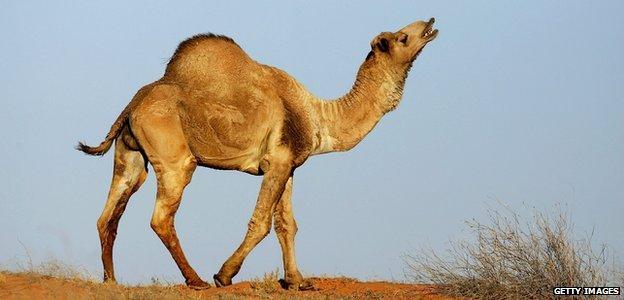Cull and drought hit feral camels
- Published

The camels are placing pressure on native animals and plant species
Numbers of wild camels in Australia have dropped by a quarter in recent years because of drought and culling, a wildlife survey shows.
The camel population was estimated at one million a few years ago, but the body tasked with controlling the animals says it has fallen to 750,000.
Introduced in the 1800s, the camels now form the world's biggest wild herd.
But the camels cause significant environmental damage, and in 2010, the government endorsed a control plan.
The Australian Feral Camel Management Project (AFCMP) aims to reduce camel densities through culling and mustering the animals for sale.
With few natural predators and vast sparsely-populated areas in which to roam, feral camels have put pressure on native Australian species by reducing food sources and destroying habitat.
"Between 2001 and 2008, it was estimated that there could have been as many as a million feral camels in the outback," said Jan Ferguson, from the not-for-profit company Ninti One, which manages the AFCMP.
"Since then, however, there has been a major drought, the feral camel management programme has come into effect and population survey techniques have been improved."
Born free
Camels roam freely across an area of 3.3 million sq km (1.3 million sq miles) encompassing the states of Western Australia, South Australia and Queensland, as well as the Northern Territory.
They are mainly dromedaries, but include a minority of bactrian camels.
About 85,000 were culled under a plan to reduce their impact on sensitive areas and native animals but Ferguson said some populations were still too dense.
Wildlife scientist Glenn Edwards said the latest monitoring, under which about 50 camels fitted with special collars were tracked using satellites, provided a clearer picture of the extensive damage they caused.
The animals were introduced in the 19th Century as pack animals
"Feral camels can travel 70km (43 miles) in one day, and hundreds of kilometres within a week, over incredibly harsh terrain," he said.
"We know that when they herd, they can converge on a natural waterhole used by native animals, and drink it dry within days.
"This has a devastating effect on the local flora and fauna and shows exactly why we need to control the population density of these animals."
The economic cost of grazing land loss and damage by feral camels has been estimated at 10 million Australian dollars (ÂŁ6.6m).
- Published1 February 2012